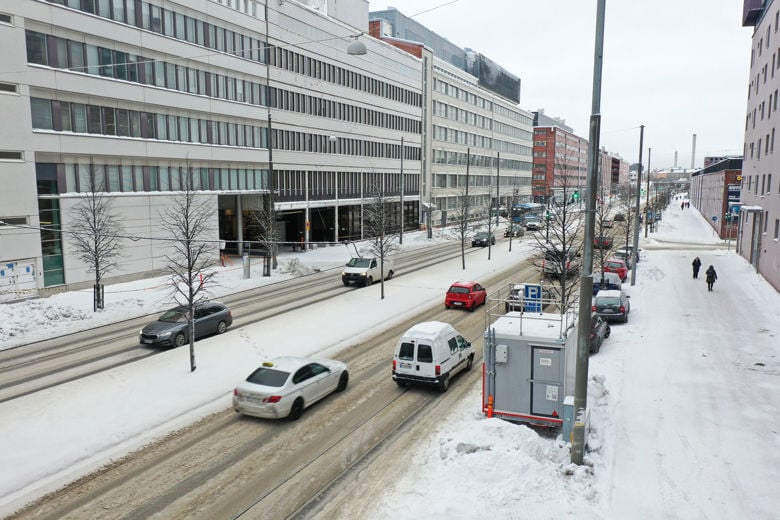Air Quality Impact of Traffic Exhaust Emissions Decreasing in the Capital Region – Street Dust and Wood Burning Smoke Remain Challenges

According to HSY, the air quality problems caused by traffic exhaust emissions in the capital region decreased in 2024. Exhaust gas concentrations declined slightly, but street dust and emissions from wood burning still occasionally deteriorate air quality. The new air quality directive tightens the limit values. In the current situation, the new limit values would be exceeded due to street dust, so it is important to invest more in combating street dust.
Exhaust Gases Decrease as the Vehicle Fleet is Renewed
According to measurements by the Helsinki Region Environmental Services Authority (HSY), nitrogen dioxide concentrations from exhaust gases decreased in the capital region in 2024.
– Exhaust gas concentrations decreased at all our air quality measurement stations last year. The renewal and electrification of the vehicle fleet will continue to reduce nitrogen dioxide concentrations in the future, says Hanna Manninen, head of HSY's air protection unit.
The current EU annual limit value for nitrogen dioxide has not been exceeded at any of HSY’s air quality measurement stations in recent years. The concentrations are also below the new, stricter limit value. However, the even stricter annual guideline value of the World Health Organization (WHO) is still exceeded in traffic-intensive environments in the capital region.
Street Dust Causes Challenges Both Along Streets and Roads
Thoracic particles, i.e., street dust, deteriorate air quality in traffic-intensive environments. In 2024, the highest number of days exceeding the limit value was measured on Teollisuuskatu in central Helsinki, with a total of 19 days. The limit value may be exceeded on a maximum of 35 days per year. WHO’s stricter guideline value was widely exceeded in traffic environments.
– Although there was the most street dust in the air in the spring, we also measured several dusty days along busy streets and roads in the autumn when the winter tire season began. Studded tires wear down the asphalt surface and produce significantly more street dust than friction tires, says Manninen. Favouring friction rings instead of studded ones could reduce the formation of street dust during the winter, she continues.
The current limit values for thoracic particles are not exceeded in the capital region. In the new directive, the daily limit value is tightened, and the number of allowed dusty days is halved. Currently, the new limit value would be exceeded in many traffic-intensive environments.
– The tightening of the street dust limit value poses major challenges along traffic-intensive roads and streets. It is important to invest more in dust control so that we can stay below the limit value by 2030, says Manninen.

In the new air quality directive, the daily limit value for thoracic particles has been tightened, and the number of allowed exceedance days has been halved.
Wood Burning Deteriorates Air Quality in Residential Areas
Wood burning produces health-damaging fine particles and black carbon, but good burning practices can reduce emissions. HSY also measured elevated levels of fine particles and black carbon in residential areas last year, especially on calm, frosty evenings.
Wood burning also produces PAH compounds that increase cancer risk. The concentrations measured in residential areas in the capital region have generally been below the current target value, which will become a new binding limit value in the future.
Information on Air Pollutants
- Limit values define the highest acceptable health-based concentrations of air pollutants. If the limit value is exceeded, the municipality must develop and implement air quality plans to stay below the limit value.
- Nitrogen oxides in the breathing air come from traffic emissions, especially from diesel cars and heavy traffic. Nitrogen dioxide is the nitrogen oxide that causes the most health damage. At high concentrations, it constricts the bronchi and increases respiratory symptoms, especially in children and asthmatics.
- Inhalable particles consist mostly of street dust stirred up by traffic and can be harmful to health. Elevated concentrations of street dust particularly impair the well-being of people with respiratory diseases.
- Fine particles are mainly produced from traffic and wood burning emissions. Additionally, they are transported to the capital region from abroad. Fine particles are considered particularly harmful to health because they can penetrate deep into the peripheral parts of the lungs. The most sensitive to health damage from air pollutants are young children and the elderly, as well as people with respiratory and heart diseases.
- Black carbon, or soot, is released into the air from incomplete combustion. The main sources of emissions in the capital region are direct exhaust emissions, wood burning in fireplaces, shipping, and long-range transport. The surfaces of soot particles released into the air during combustion are coated with health-damaging organic compounds, such as PAH compounds, other organic compounds, and metals.
More Information
- Street Dust
- Tips for Wood Burning: Burn Wood Cleanly
- Health Effects of Air Pollutants
- Air Quality Regulations
- Friction tires
- Head of Air Quality Unit Hanna Manninen, hanna.manninen@hsy.fi